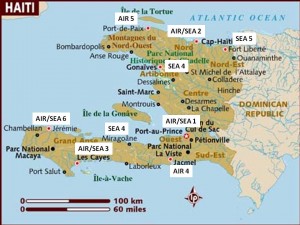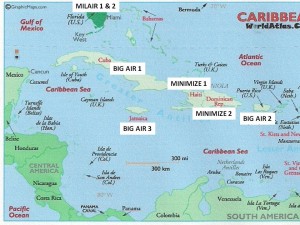
Here are the viable air and sea landing points for Haiti, trying to leave Dominican Republic out of it, they have enough problems.
Below are a few “Big Air” triage points, with corresponding seaport triage that can then be migrated to small boats, landing craft, etcetera.
So here is the silly question…has anybody thought to set up a regional traffic management plan that triages big air into little air and big boats into small boats?

Has anyone set up a bottom-up Range of Needs Table?
Has anyone convened a Haitian Population Resettlement Council that goes straight to moving 400,000 to new zones where free lumber, bricks, cement and so on can be brought in by landing craft?
This would appear to be a huge opportunity to think before acting, and to then execute several strategic moves that lift Haiti out of poverty rather than just covering up the mess in the short term. Civil Affairs Brigade could really make a difference here, along with STRONG ANGEL It is very rugged terrain but the ocean is open and people can be moved by landing craft and ambhibious ships. IOHO.
Afterthought: USMC learned in 1989 that the “big ship” Navy for always 4-6 steaming days away from anywhere that mattered in the Third World, the same is probably true abaout C-130's and the mix of small craft and small planes needed to do triage from Big Air at intermediate landing strips to the 9-11 small uasable strips in Haiti. It also merits study, if the US military has dismissed all but one of those Haitian airstrips (using Port au Prince and Jacmel) when local aviaition is in and out of them, the question has to be asked: why? Haiti is a classic “distributed chaos” problem that needs a distributed “small” answer. This is also a classic mission area where being able to do C4I with everyone regardless of their C4I capabilities and standards, is a non-negotiable necessity if a massive log-jam is to be avoided.



